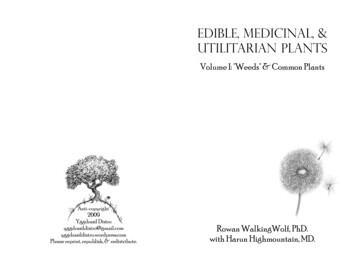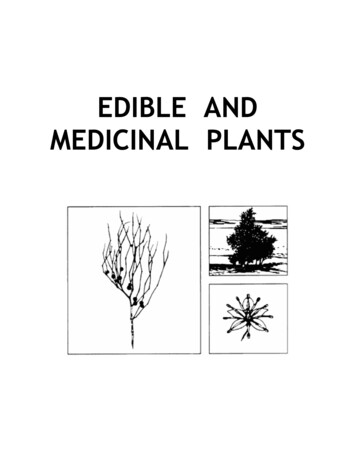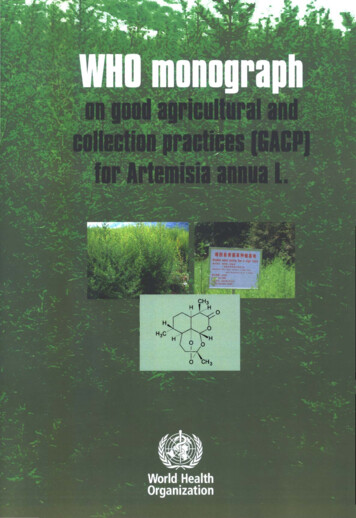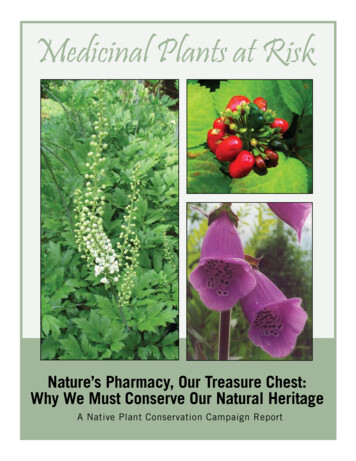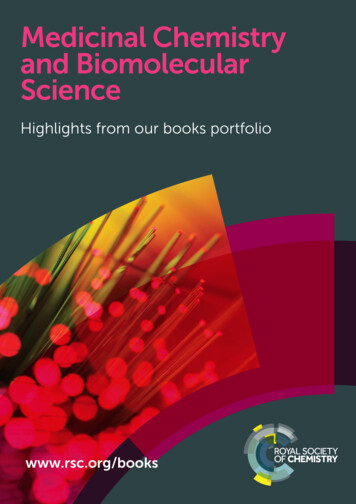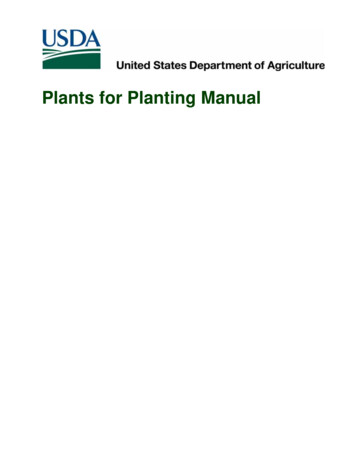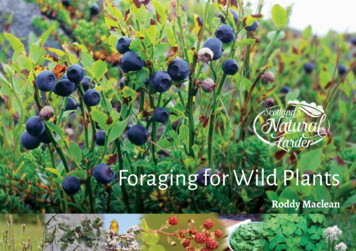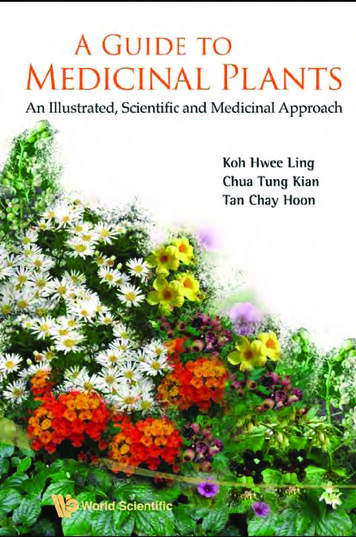
Transcription
Medicinal Plants of the North CascadesSpecific to the Environmental Learning CenterNatural History Project and PresentationMartine MariottCandidate for Master’s in Environmental EducationWestern Washington University and North Cascades InstituteSummer 2010
Medicinal Plants of the North CascadesSpecific to the NCI Environmental Learning CenterOf all forms of life, plants are the most vital to all others. Through photosynthesis plants convertsolar energy into chemical energy which is then carried up the food chain to the top where Homosapiens are found. The connection we have with plants is critical and life giving. In addition toproviding the oxygen we breathe, plants often have complex molecular structures that are able toheal our bodies. Every ancient culture known to man has had some form of medicinalrelationship with plants. Sites in Iraq dated to 50,000 years ago show Neanderthals used yarrowfor its medicinal properties. The earliest known medical document is a Sumerian clay tabletoutlining various plant remedies for illnesses. The ancient Chinese, Egyptian, Greek, Roman,and Hindu cultures all had herbal medicine literature. In the Americas, the oldest known medicaltext recorded Aztex herbology and was translated by Juan Badiano. The document is called theBadianus Manuscript and it now resides in the Vatican.Texts were often laced with the supernatural and the ethereal. People who practiced medicinewere known to have a sensitivity that bordered on omnipotent capabilities. Amongst numerousother titles these apothecaries, herbalists, shamans, priests (later to become physicians),sorcerers, witches, and wizards (today’s toxicologists) could heal with their knowledge. Withthe advent of Christian religion many healers were persecuted. Earth or nature orientedphilosophies were considered a threat to control and order, blasphemies. In Western culture aseparation between medicine and spirituality is still seen.The Pacific Northwest’s First Nations’ People saw the spiritual world and the physical world asconnected. This relationship resulted in an extraordinary awareness of life and energy. The FirstNation’s People believed, like many other cultures, that there was a communication betweenplant and man. Many insist they learned from the plant itself about its uses. Modern objectivethought reasons that our knowledge of plants evolved over time through trial and error, but thatthe possibility of us having lost a sense of awareness is equally plausible. It would not be thefirst sense that humanity has lost.Today plants are still used by the pharmaceutical industry. Approximately 25% of prescriptionswritten in the US are plant derived. China leads the world in medicinal plant usage byincorporating it in there modern health care system. Herbal medicine is still relied upon from75% to 90% of the rural population of the world. And although Western medicine has swayedfrom herbal medicine there seems to be a conscious effort being made by the scientificcommunity to investigate plant species. Much interest has been focused on the tropicalrainforests with the hope that new plants will be found for pharmaceutical industry before theyare gone forever.Plants have been known to cure ailments for thousands of years, and the First Nation’s Peoplehave been using plants found here for almost as long. Nearly every plant in the PacificNorthwest has had some medicinal use; however, some seem to be more revered than others.These plants are still used today by herbalists and have some chemical compounds that arerecognized by modern medicine. Hands on learning is one of the most effective learning stylesknown, but before running out to harvest local medicinal plants please take ethical considerationof the process. Refer to the wildcrafting page for harvesting guidelines. Happy Harvesting!
PLANT INDEXDEVIL’S CLUBOplopanax horridusHabitat: Moist woods, avalanche tracks, stream banksLocation: Spine trail, between the Lily Shelter and theservice roadHarvest Season: Late spring – early summer, beforeflowering.Medical Attributes: Roots and stems used in steambaths for rheumatism and stomach trouble. Tea made from leaves and bark wasdrunk for colds, tuberculosis, fever reduction, diabetes and re-establishmentmenstruation after child birth. Dethorned bark was applied to women’s breasts tostop the flow of milk and berries were rubbed on the head to combat lice anddandruff. Bark and shredded inner root was applied as poultice (moist mass balleduntil gooey and placed on wound) for boils and infections. Pulverized bark wasused as perfume, baby talc, and deodorant.Application: Shave the outer layer of the root to get to the greenish inner bark. Make atincture of the shredded inner bark. Let the tincture steep for 6 weeks.Factoids: Member of the Ginseng family. Protects against evil influences.FOXGLOVEDigitalis PurpureaHabitat: Roadsides, fields, forest edgesLocation: Dam Road, Buster Brown Field, Diablo East Trail,Sourdough TrailHarvest Season: Late spring – early summerMedicinal Attributes: Used for congested heart failure andatrial fibrillation (chaotic contractions of the heart) bypumping more liquids to the kidneys, stimulating urination. Contains the chemicalcompound Digitoxin, a stimulant that improves heart tone and rhythm, by blocking anenzyme that regulates the heart’s electrical activity; the compound also slows the pulsationrate of the human heart.Application: Picked when the bloom spike has ran up the length of the stock and about twothirds of the flowers are present; powdered foxglove leaves of two-year old plants areadministered in pill form, leaf tinctures.Factoids: Extremely poisonous and fatal in large doses. Introduced to the Pacific Northwestfrom Europe. The name "dead man’s thimbles" is used to refer to the foxglove in Ireland.
KINNIKINNICKArctostaphylos uva-ursi(Bearberry)Habitat: Sandy, well-drained, dry rocky slopes, clearingsLocation: ELC campus decretive shrub, Buster BrownLookout (higher elevation), Diablo East TrailHarvest Season: Late spring – early summerMedical Attributes: Used as a diuretic for kidney diseaseand urinary infections, relaxation.Application: Tea leaves used as diuretic, dried leaves smoked for recreation.Factoids: Hallucinogenic if smoked in large quantities, often supplemented with tobacco toextend the supply.OREGON GRAPEMahonia nervosaHabitat: Low to middle elevationsLocation: All ELC trails, used as a decretive shrub on theELC campusHarvest Season: Early spring, late autumnMedical Attributes: Drank in tea as a general tonic.Contains berberine – a strong antimicrobial (kills orinhibits microorganisms – protozoa, bacteria, fungi), and is high in vitamin C. It has beenknown to treat infections, sore throats, and venereal diseases. The bark and berries werealso used for digestive problems.Application: To make a tincture: gently strip the brown outer layer of the root to access thefibrous orange-yellow layer. Separate the orange-yellow layer of root from the remainingbase white root. The orange-yellow layer has the medicinal properties. Add 100 - proofalcohol to the shavings of the orange-yellow layer. Let steep for 6 weeks. Add two drops oftincture to hot tea and honey – too much can cause stomach irritation. Can add cedarneedles to the tincture for additional vitamin C.Factoids: Evergreen, inner root used to make yellow dye by First Nation’s People.
PACIFIC YEWTaxus brevifolia(Western Yew)Habitat: Moist – mature Douglas Fir and Western HemlockforestsLocation: Before Fawn Creek Shelter on Sourdough Trail andDiablo East TrailIdentifying Features: Droopy and sickly looking with reddishscaly-shreddy barkMedical Attributes: Produces a cancer fighting compound – Taxol – found in the bark andneedles. Cancers that taxol is used to combat include: ovarian, testis, breast, lung cancer,melanoma, head and neck cancer.Application: Taxol is used in combination with other chemotherapy drugs to bind topolymerised tublin (protein involved in mitosis), stabilizing it against disassembly andconsequently inhibiting mitosis, metabolizing in the liver.Factoids: Discovered in the 1960’s the compound was not approved by the FDA for first-linetreatment of carcinoma until 1992. In 1997 the FDA approved taxol for second-linetreatment for AIDS. The tree became endangered due to over harvesting until a syntheticform of taxol was created in 1995.PIPSISSEWAChimaphila umbellate(Prince’s-pine)Habitat: Well-drained forests and clearingsLocation: All trailsIndentifying Features: Serrated leaves with a dark stockstemming from the center of the plant with spheres onthe endHarvest Season: Late spring – early summerMedical Attributes: Used for kidney stones, bladder inflammation and eye sores. Displayshypoglycemic (lowers blood sugar) and anti-diuretic properties. Infusions used for urinarytract problems such as cystitis (inflammation of the urinary bladder) and urethritis(inflammation of the urethra).Application: Tea made from the leaves.Factoids: In Cree means “breaks-into-small-pieces” referring to kidney stones. Secret ingredientof popular soda lead(s) to commercial over-harvesting in the Pacific Northwest. (Pepsi?)
STINGING NETTLEUrtica dioicaHabitat: Meadows, thickets, stream beds, open forests,disturbed areas.Location: Cross roads between Service Road and SourdoughCreek TrailIndentifying Features: Heart-shaped seriated leaves. Longthin stem, 1-3m tallHarvest Season: Spring, leaves before flowers bloom – tea. Fall stems can be used to maketwine and rope.Medical Attributes: General spring tonic (anything that enlivens or strengthens), postpartumtonic – replaces trace minerals after childbirth.Application: Cutting off the tops of the plants does not kill them. Leaves can be dried byhanging or placing in a paper bag that is shaken every day until dry. Drying the nettlesdeactivates the stinging agent, however, the plant will still have thorns with small amountsof formic acid on them – gloves are recommended.Factoids: 30% - 50% of its weight is protein. Leaves are also good for eating and make adelicious pesto sauce.YARROWAchillea millefoliumHabitat: Well drained open sites; roadsides, clearings, rockyslopesLocation: Buster Brown Field, Dam Road, Waterfall –Sourdough Creek TrailIdentifying Features: Fern-like leaves, usually 5 ray flowersHarvest Season: Late spring – early summerMedical Attributes: One of the oldest known herbalmedicines in the world, it has been used for: expectorant (helps dissolve thick mucus andother material from the lungs), analgesic (pain reliever), diaphoretic (promotes sweating),various circulatory diseases, and blood coagulatant (stops bleeding).Application: Leaves – tea, poultice (moist mass of leaves balled until gooey and placed onwound).Factoids: Poultice applied to Achilles’ tendon when severed, hence the name. Leaves may berubbed into skin as an insect repellent.
WildcraftingWildcrafting is the process of harvesting plants from their natural environment for food,medicine, and/or other human materials.Harvesting Guidelines1.2.3.4.5.6.Get permission from landowner. The North Cascades Environmental Learning Center isin a National Park and is therefore illegal to harvest without consent of the Park. TheCascade River Road in Marblemount leads in to National Forest Land and is a goodoption for wildcrafters near the ELC.Make sure the plant is strong and vital. Harvest in the proper growing phase. Plants areparticularly susceptible to pollution; harvest away from roads and other sources ofcontaminates such as downstream from livestock or areas known to have had pesticideuse.Never take more than 25% from a given stand and make sure there is at least 10 speciesof the plant in the surrounding area before harvesting. Always leave the largest andsmallest members of the plant community. Of course, never harvest endangered orthreatened species.Monitor harvest areas every year to ensure the health of the plant community.Properly identify the plant. There are many lookalikes out there that may cause adverseeffects.Don’t harvest more than needed. This seems obvious but can be tricky for beginners.Wildcrafters can always return to the area if need be.Collection SeasonsRoots – Collect roots in early spring or late autumn. Before it buds or after the aerial part of theplant begins to wither. Plants are usually dormant during these times and store their nutrients inthe roots.Bark – Late spring and early summer is a good time to collect plants for their bark. The plantsare in their growing phase and have ample sap. The bark has more nutrients at this time and ismore easily separated from the woody parts.Stems, branches, leaves – In general, whole plant parts should be collected in the late spring andearly summer when they are growing luxuriantly.Flowers – It is advised to collect flowers for medicinal purposes as buds or just beginning tobloom to avoid loss of fragrance and petals. Collect over several separate occasions to allow theplant to recuperate.Fruits – Collect when ripe. Some species may need to be collected beforehand. Consult guide.Seeds and kernels – When fruit is completely ripe. Fruits that would crack and lose their seedsare collected on sunny days as soon as they are ripe but have not yet cracked.
RESOURCE LISTBOOKSGahlinger, Paul, (2004). Illegal Drugs: A Complete Guide to Their History, Chemisty, Use, andAbuse. New York, NY: Penguin GroupGunther, Erna, (1973). Ethnobotany of Western Washington: The Knowledge and use ofIndigenous Plants by Native Americans (Rev. ed.). Seattle, WA: University ofWashington.Pojar, Jim, and Andy MacKinnon, (2004). Plants of the Pacific Northwest Coast (Rev. ed.).Vancouver, British Columbia: Lone Pine Publishing.Tilford, Gregory, (1997). Edible and Medicinal Plants of the West. Missoula, MT: MountainPress Publishing Company.Turner, Nancy, (1998). Plant Technology of First Peoples in British Columbia. Vancouver, BC:UBC Press.Weiner, Michael, (1972). Earth Medicine Earth Food: Plant Remedies, Drugs, & Natural Foodsthe North American Indians. (1972). New York, NY: Collier Books.RESEARCH PAPERSBodmer, Laurie, (2005). Select Native American Medicinal Plants. Bellingham, WA: WesternWashington University.Durham, Heather, (2009). Pacific Northwest Ethnobotany: Traditional Uses of Common LocalFlora. Rockport, WA: North Cascades Institute.Park, Cynthia, (2008). Ethnobotany of the Pacific Northwest: An Edible Plant Walk from theNorth Cascade’s Environmental Learning Center. Bellingham, WA: WesternWashington University.Pilarski, Michael and Allison Lutz (1999). Ethnobotany and Ethnoecology Resource Guide.Belingham, WA: Western Washington University.WEBSITESAmerican Indian Ethnobotany Databasehttp://herb.umd.umich.edu/US Food and Drug Administrationhttp://www.fda.gov/
outlining various plant remedies for illnesses. The ancient Chinese, Egyptian, Greek, Roman, and Hindu cultures all had herbal medicine literature. In the Americas, the oldest known medical text recorded Aztex herbology and was translated by Juan Badiano. The document is called t

